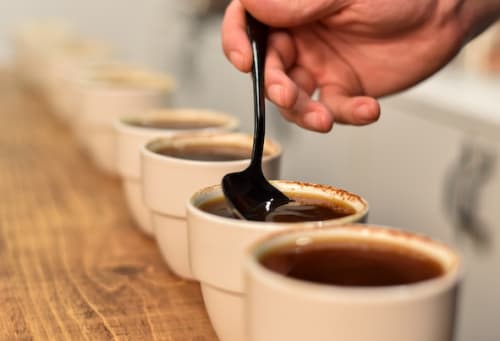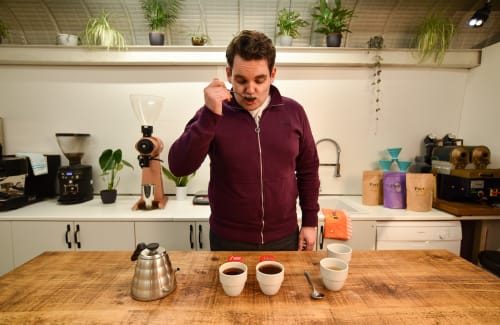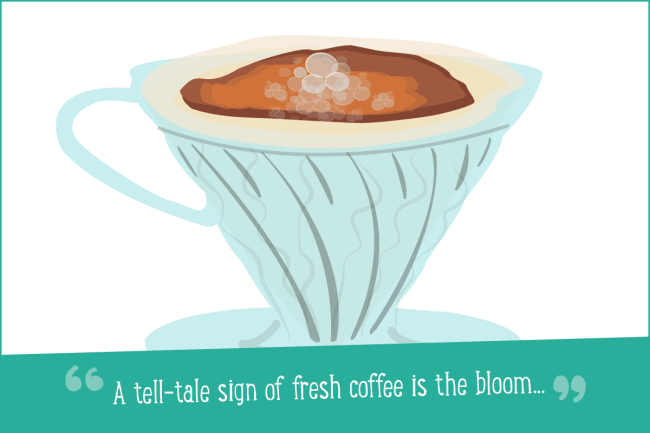You might think that coffee cupping (or tasting) is a complicated exercise that’s best left to the experts. However, armed with a little knowledge and guidance, you too can start sipping the good stuff like a pro.
We’ve put together this guide to give you the lowdown on exactly what to look for in your brew, and our ideal coffee tasting method.

Flavour profiles and characteristics
Every coffee has its own unique flavour profile, and speciality coffees offer exceptional clarity so that these flavours are more pronounced. Here are the main characteristics you should look for when tasting coffee…
Flavours - We never add any flavouring or chemicals to our coffee, so when you see us talking about the hints or tasting notes, what we’re referring to is what the coffee’s natural flavours remind us of – such as chocolate, dates, or even fruit salad sweets!
Mouthfeel - Meaning, quite literally, how the coffee feels in your mouth: is it round, silky or chewy?
Acidity - This is the sensation on your tongue when you sip the coffee, it can be high or low and might be citric (oranges and lemons), malic (apples) or tartaric (grapes) in nature.
Sweetness - There is no sugar in coffee, but all the other elements combine to create the illusion of sweetness. So when tasting coffee, consider what this sweetness reminds you of – it could be anything from baked fruit to biscuits.

What is speciality coffee?
To be considered speciality, a coffee has to be awarded a quality score of at least 80 and be free of any defects. We’re very proud that all the coffees we sell are speciality, and our micro-lots score even higher at 86 or more.
This quality score takes into account various aspects of the coffee such as the balance between bitterness and sweetness, the level of acidity, and how well developed those flavour notes are.
Some lingo to know
Before you get tasting, it’s good to know some overarching terms that determine the kind of coffee you’re getting.
Firstly, the kind of coffee plant is important to know for the overall characteristics before varietals, growing conditions and processing techniques come in.
There are two main types of coffee - Robusta and Arabica.
Robusta - Robusta coffee originates in Africa, from the Coffea canephora plant. Generally speaking it’s more bitter, and it has more caffeine and less acidity.
Arabica - Arabica coffee originates in Ethopia, from the Coffea arabica plant. It’s the most popular coffee type worldwide. It also has a huge range of flavours.
Secondly, take note of whether your coffee is roasted for filter or espresso. Coffees intended for espresso can work well for filter, particularly if you like a darker roast, but coffees roasted for filter coffee will not extract well in espresso machines.
Finally, is your coffee a blend?
Blend - If your coffee is a blend, it will tend to be balanced. It will either be blended to be a good all-rounder that you can enjoy with milk or it will be purpose-blended to achieve a particular taste.
Single estate - If your coffee is single estate, depending on the roast, you may find it best to enjoy black. Single-estate coffees will have distinctive tastes depending on the region and the varietal used.
Top coffee tasting tips
Ideally we’d recommend brewing a couple of different coffees at the same time to compare and contrast flavour notes. Try a mix of darker and lighter roasts, flavour profiles (chocolatey, fruity and floral), and from various different origins. This will allow you to really appreciate the different characteristics and flavours in each one. Alternatively, just brew the one coffee and try your hand at the following tips…
- Smell the dry fragrance of coffee first, and then compare it to the wet brewed aroma.
- Try the coffee black - milk and sugar dilute the flavour.
- When tasting, hold the coffee in your mouth and swirl it around, breathing in and out through your nose for a few seconds before swallowing.
- Taste the coffee through its temperature journey, all the way from hot to cold.
Which coffees will you taste?
Take a look at our Coffee Menu and choose some coffees for your very own tasting session!







